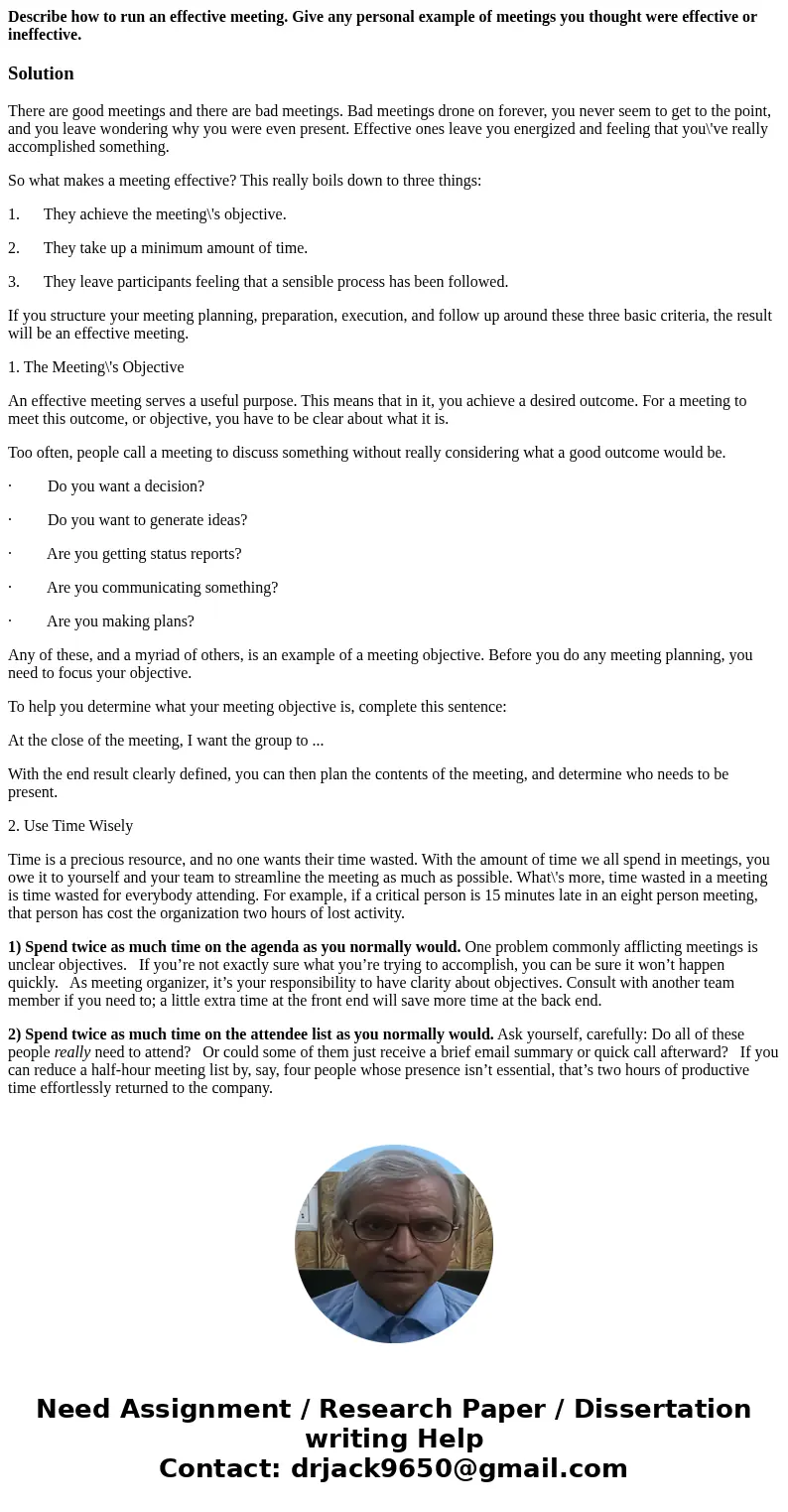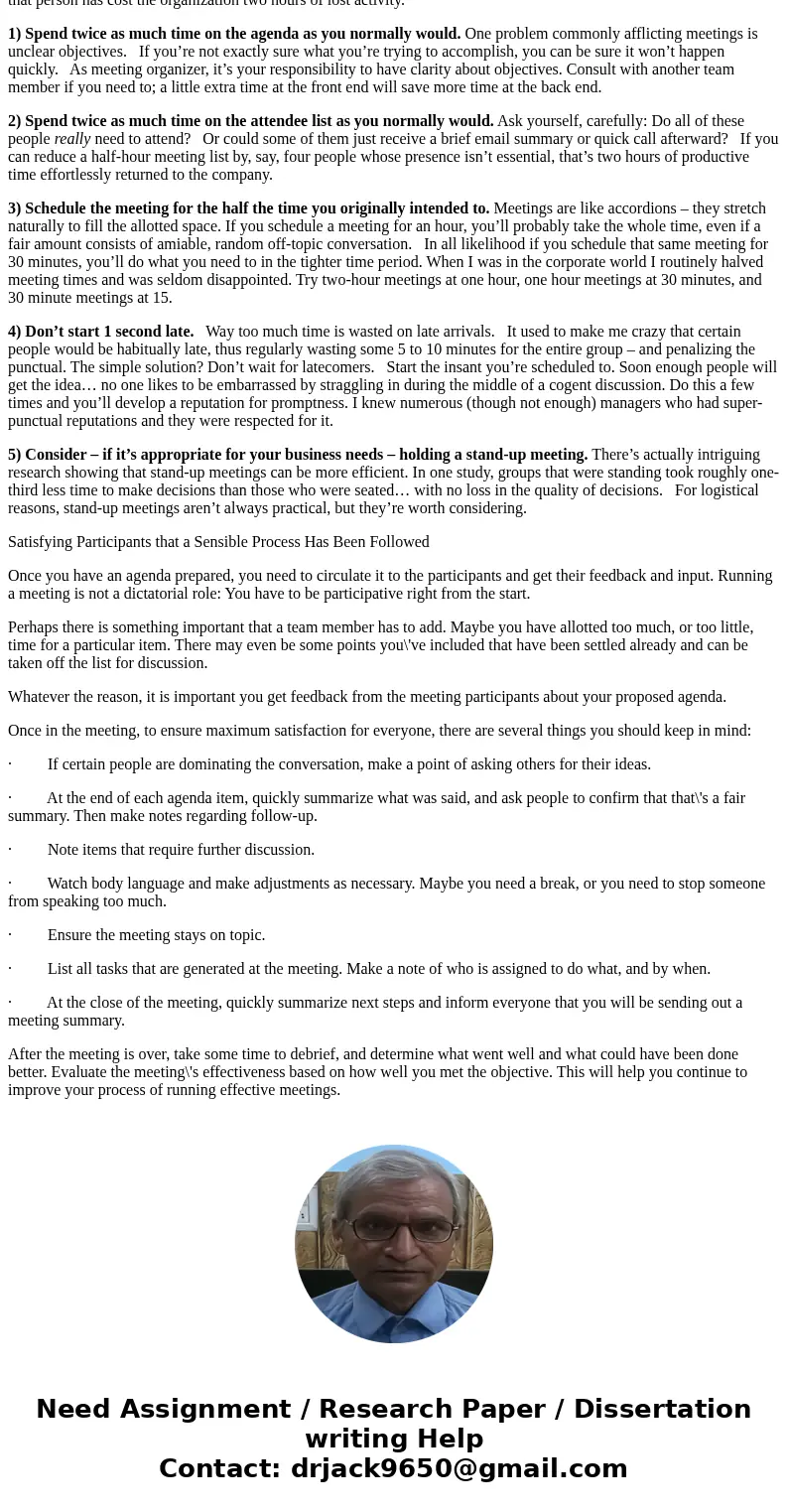Describe how to run an effective meeting Give any personal e
Describe how to run an effective meeting. Give any personal example of meetings you thought were effective or ineffective.
Solution
There are good meetings and there are bad meetings. Bad meetings drone on forever, you never seem to get to the point, and you leave wondering why you were even present. Effective ones leave you energized and feeling that you\'ve really accomplished something.
So what makes a meeting effective? This really boils down to three things:
1. They achieve the meeting\'s objective.
2. They take up a minimum amount of time.
3. They leave participants feeling that a sensible process has been followed.
If you structure your meeting planning, preparation, execution, and follow up around these three basic criteria, the result will be an effective meeting.
1. The Meeting\'s Objective
An effective meeting serves a useful purpose. This means that in it, you achieve a desired outcome. For a meeting to meet this outcome, or objective, you have to be clear about what it is.
Too often, people call a meeting to discuss something without really considering what a good outcome would be.
· Do you want a decision?
· Do you want to generate ideas?
· Are you getting status reports?
· Are you communicating something?
· Are you making plans?
Any of these, and a myriad of others, is an example of a meeting objective. Before you do any meeting planning, you need to focus your objective.
To help you determine what your meeting objective is, complete this sentence:
At the close of the meeting, I want the group to ...
With the end result clearly defined, you can then plan the contents of the meeting, and determine who needs to be present.
2. Use Time Wisely
Time is a precious resource, and no one wants their time wasted. With the amount of time we all spend in meetings, you owe it to yourself and your team to streamline the meeting as much as possible. What\'s more, time wasted in a meeting is time wasted for everybody attending. For example, if a critical person is 15 minutes late in an eight person meeting, that person has cost the organization two hours of lost activity.
1) Spend twice as much time on the agenda as you normally would. One problem commonly afflicting meetings is unclear objectives. If you’re not exactly sure what you’re trying to accomplish, you can be sure it won’t happen quickly. As meeting organizer, it’s your responsibility to have clarity about objectives. Consult with another team member if you need to; a little extra time at the front end will save more time at the back end.
2) Spend twice as much time on the attendee list as you normally would. Ask yourself, carefully: Do all of these people really need to attend? Or could some of them just receive a brief email summary or quick call afterward? If you can reduce a half-hour meeting list by, say, four people whose presence isn’t essential, that’s two hours of productive time effortlessly returned to the company.
3) Schedule the meeting for the half the time you originally intended to. Meetings are like accordions – they stretch naturally to fill the allotted space. If you schedule a meeting for an hour, you’ll probably take the whole time, even if a fair amount consists of amiable, random off-topic conversation. In all likelihood if you schedule that same meeting for 30 minutes, you’ll do what you need to in the tighter time period. When I was in the corporate world I routinely halved meeting times and was seldom disappointed. Try two-hour meetings at one hour, one hour meetings at 30 minutes, and 30 minute meetings at 15.
4) Don’t start 1 second late. Way too much time is wasted on late arrivals. It used to make me crazy that certain people would be habitually late, thus regularly wasting some 5 to 10 minutes for the entire group – and penalizing the punctual. The simple solution? Don’t wait for latecomers. Start the insant you’re scheduled to. Soon enough people will get the idea… no one likes to be embarrassed by straggling in during the middle of a cogent discussion. Do this a few times and you’ll develop a reputation for promptness. I knew numerous (though not enough) managers who had super-punctual reputations and they were respected for it.
5) Consider – if it’s appropriate for your business needs – holding a stand-up meeting. There’s actually intriguing research showing that stand-up meetings can be more efficient. In one study, groups that were standing took roughly one-third less time to make decisions than those who were seated… with no loss in the quality of decisions. For logistical reasons, stand-up meetings aren’t always practical, but they’re worth considering.
Satisfying Participants that a Sensible Process Has Been Followed
Once you have an agenda prepared, you need to circulate it to the participants and get their feedback and input. Running a meeting is not a dictatorial role: You have to be participative right from the start.
Perhaps there is something important that a team member has to add. Maybe you have allotted too much, or too little, time for a particular item. There may even be some points you\'ve included that have been settled already and can be taken off the list for discussion.
Whatever the reason, it is important you get feedback from the meeting participants about your proposed agenda.
Once in the meeting, to ensure maximum satisfaction for everyone, there are several things you should keep in mind:
· If certain people are dominating the conversation, make a point of asking others for their ideas.
· At the end of each agenda item, quickly summarize what was said, and ask people to confirm that that\'s a fair summary. Then make notes regarding follow-up.
· Note items that require further discussion.
· Watch body language and make adjustments as necessary. Maybe you need a break, or you need to stop someone from speaking too much.
· Ensure the meeting stays on topic.
· List all tasks that are generated at the meeting. Make a note of who is assigned to do what, and by when.
· At the close of the meeting, quickly summarize next steps and inform everyone that you will be sending out a meeting summary.
After the meeting is over, take some time to debrief, and determine what went well and what could have been done better. Evaluate the meeting\'s effectiveness based on how well you met the objective. This will help you continue to improve your process of running effective meetings.


 Homework Sourse
Homework Sourse